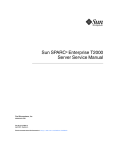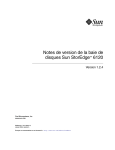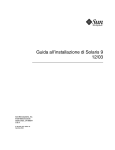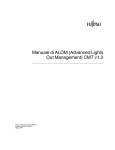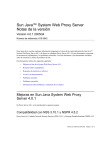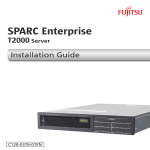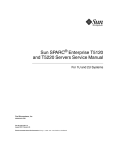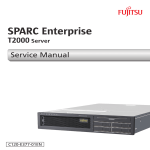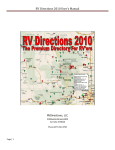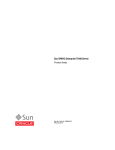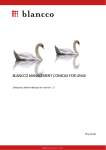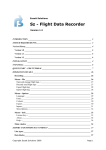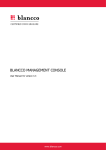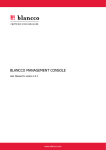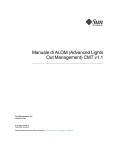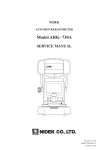Download Sun Fire T1000 Server Product Notes
Transcript
Sun Fire™T1000 Server Product Notes Sun Microsystems, Inc. www.sun.com Part No. 819-3246-11 March 2006, Revision A Submit comments about this document at: http://www.sun.com/hwdocs/feedback Copyright 2006 Sun Microsystems, Inc., 4150 Network Circle, Santa Clara, California 95054, U.S.A. All rights reserved. Sun Microsystems, Inc. has intellectual property rights relating to technology that is described in this document. In particular, and without limitation, these intellectual property rights may include one or more of the U.S. patents listed at http://www.sun.com/patents and one or more additional patents or pending patent applications in the U.S. and in other countries. This document and the product to which it pertains are distributed under licenses restricting their use, copying, distribution, and decompilation. No part of the product or of this document may be reproduced in any form by any means without prior written authorization of Sun and its licensors, if any. Third-party software, including font technology, is copyrighted and licensed from Sun suppliers. Parts of the product may be derived from Berkeley BSD systems, licensed from the University of California. UNIX is a registered trademark in the U.S. and in other countries, exclusively licensed through X/Open Company, Ltd. Sun, Sun Microsystems, the Sun logo, AnswerBook2, docs.sun.com, OpenBoot, SunVTS, Netra, Sun Fire, Java, SunSolve, and Solaris are trademarks or registered trademarks of Sun Microsystems, Inc. in the U.S. and in other countries. All SPARC trademarks are used under license and are trademarks or registered trademarks of SPARC International, Inc. in the U.S. and in other countries. Products bearing SPARC trademarks are based upon an architecture developed by Sun Microsystems, Inc. The OPEN LOOK and Sun™ Graphical User Interface was developed by Sun Microsystems, Inc. for its users and licensees. Sun acknowledges the pioneering efforts of Xerox in researching and developing the concept of visual or graphical user interfaces for the computer industry. Sun holds a non-exclusive license from Xerox to the Xerox Graphical User Interface, which license also covers Sun’s licensees who implement OPEN LOOK GUIs and otherwise comply with Sun’s written license agreements. U.S. Government Rights—Commercial use. Government users are subject to the Sun Microsystems, Inc. standard license agreement and applicable provisions of the FAR and its supplements. DOCUMENTATION IS PROVIDED "AS IS" AND ALL EXPRESS OR IMPLIED CONDITIONS, REPRESENTATIONS AND WARRANTIES, INCLUDING ANY IMPLIED WARRANTY OF MERCHANTABILITY, FITNESS FOR A PARTICULAR PURPOSE OR NON-INFRINGEMENT, ARE DISCLAIMED, EXCEPT TO THE EXTENT THAT SUCH DISCLAIMERS ARE HELD TO BE LEGALLY INVALID. Copyright 2006 Sun Microsystems, Inc., 4150 Network Circle, Santa Clara, Californie 95054, Etats-Unis. Tous droits réservés. Sun Microsystems, Inc. a les droits de propriété intellectuels relatants à la technologie qui est décrit dans ce document. En particulier, et sans la limitation, ces droits de propriété intellectuels peuvent inclure un ou plus des brevets américains énumérés à http://www.sun.com/patents et un ou les brevets plus supplémentaires ou les applications de brevet en attente dans les Etats-Unis et dans les autres pays. Ce produit ou document est protégé par un copyright et distribué avec des licences qui en restreignent l’utilisation, la copie, la distribution, et la décompilation. Aucune partie de ce produit ou document ne peut être reproduite sous aucune forme, par quelque moyen que ce soit, sans l’autorisation préalable et écrite de Sun et de ses bailleurs de licence, s’il y en a. Le logiciel détenu par des tiers, et qui comprend la technologie relative aux polices de caractères, est protégé par un copyright et licencié par des fournisseurs de Sun. Des parties de ce produit pourront être dérivées des systèmes Berkeley BSD licenciés par l’Université de Californie. UNIX est une marque déposée aux Etats-Unis et dans d’autres pays et licenciée exclusivement par X/Open Company, Ltd. Sun, Sun Microsystems, le logo Sun, AnswerBook2, docs.sun.com, OpenBoot, SunVTS, Netra, Sun Fire, Java, SunSolve, et Solaris sont des marques de fabrique ou des marques déposées de Sun Microsystems, Inc. aux Etats-Unis et dans d’autres pays. Toutes les marques SPARC sont utilisées sous licence et sont des marques de fabrique ou des marques déposées de SPARC International, Inc. aux Etats-Unis et dans d’autres pays. Les produits portant les marques SPARC sont basés sur une architecture développée par Sun Microsystems, Inc. L’interface d’utilisation graphique OPEN LOOK et Sun™ a été développée par Sun Microsystems, Inc. pour ses utilisateurs et licenciés. Sun reconnaît les efforts de pionniers de Xerox pour la recherche et le développement du concept des interfaces d’utilisation visuelle ou graphique pour l’industrie de l’informatique. Sun détient une license non exclusive de Xerox sur l’interface d’utilisation graphique Xerox, cette licence couvrant également les licenciées de Sun qui mettent en place l’interface d’utilisation graphique OPEN LOOK et qui en outre se conforment aux licences écrites de Sun. LA DOCUMENTATION EST FOURNIE "EN L’ÉTAT" ET TOUTES AUTRES CONDITIONS, DECLARATIONS ET GARANTIES EXPRESSES OU TACITES SONT FORMELLEMENT EXCLUES, DANS LA MESURE AUTORISEE PAR LA LOI APPLICABLE, Y COMPRIS NOTAMMENT TOUTE GARANTIE IMPLICITE RELATIVE A LA QUALITE MARCHANDE, A L’APTITUDE A UNE UTILISATION PARTICULIERE OU A L’ABSENCE DE CONTREFAÇON. Please Recycle Contents Support for the Sun Fire T1000 Server Technical Support Software Resources 1 1 1 Supported Versions of Firmware and Software Patch Information 2 Mandatory Patches ▼ 2 2 To Download Patches 3 Patches for Option Cards 3 Known Issues and Workarounds 4 Hardware Installation and Service Issues 4 Chassis Cover Might Be Difficult to Remove (CR 6376423) General Functionality Issues Sun Explorer Utility 4 4 4 Solaris Predictive Self-Healing Fault Messages Network Port Performance (CR 6346149) 5 6 System Will Not Power On With an Invalid Memory Configuration (CR 6300114) 6 Erroneous Messages Displayed After a Repair (CR 6369961) 7 Disk Drive Write Cache Enabled By Default 7 iii ▼ To Disable the Write Cache Bug List 7 9 Sun Fire T1000 Server Documentation Downloading Documentation Documentation Errata 14 14 14 Correction for the Sun Fire T1000 Server Installation Guide Correction for the Sun Fire T1000 Service Manual ▼ iv To Manually Clear Fault Logs Sun Fire T1000 Server Product Notes • March 2006 15 14 14 Sun Fire T1000 Server Product Notes These product notes contain important and late-breaking information about the Sun Fire™ T1000 server. Support for the Sun Fire T1000 Server Technical Support If you have any technical questions or issues that are not addressed in the Sun Fire T1000 server documentation, contact your local Sun™ Services representative. For customers in the U.S. or Canada, call 1-800-USA-4SUN (1-800-872-4786). For customers in the rest of the world, find the World Wide Solution Center nearest you by visiting the web site: http://www.sun.com/service/contacting/solution.html Software Resources The Solaris™ Operating System and Sun Java™ Enterprise System software are preinstalled on your Sun Fire T1000 server. If it becomes necessary to reload the software, go to the following web site. You will find instructions for downloading software. http://www.sun.com/software/preinstall/ 1 Note – If you download a fresh copy of software, that software might not include patches that are mandatory for your Sun Fire T1000 server. After installing the software, see “Patch Information” on page 2 for a procedure to check for the presence of patches on the system. Supported Versions of Firmware and Software The following firmware and software versions are supported in this release of the Sun Fire T1000 server: ■ Solaris 10 1/06 Operating System (OS) ■ Sun Java Enterprise System software (Java ES 2005Q4) ■ Sun system firmware 6.1.2, which includes Advanced Lights Out Manager (ALOM) CMT 1.1.2 software and OpenBoot™ 4.20.0 firmware. Patch Information Mandatory Patches You must install the following patches if they are not present on your system. To determine if the patches are present, see “To Download Patches” on page 3. ■ ■ ■ 122027-01 or greater 119578-16 or greater 118822-30 or greater The following patch is mandatory for Sun™ Cluster software: ■ 119715-10 or greater Note – These patches are not included in some versions of preinstalled software on the Sun Fire T1000 server. If the patches are missing from your server, download them from SunSolveSM as described in “To Download Patches” on page 3. 2 Sun Fire T1000 Server Product Notes • March 2006 ▼ To Download Patches 1. Determine whether the patches have been installed on your system. For example, using the showrev command, type the following for each patch number: # showrev -p | grep "Patch: 119578" ■ If you see patch information listed for the queried patch, and the dash extension (the last two digits) matches or exceeds the required version, your system has the proper patches already installed and no further action is required. For example, if patch 119578-16 or later is installed, your system has the required version of this patch. ■ If you do not see patch information listed for the queried patch, or if the dash extension precedes the required version, go to Step 2. For example, if no version of the 119578 patch, or a version with an extension of -15 or earlier is installed, you must download and install the new patch. 2. Go to http://www.sun.com/sunsolve to download the patches. Using the SunSolve PatchFinder tool, specify the base Patch ID number (the first six digits) to access the current release of a patch. 3. Follow the installation instructions provided in a specific patch’s README file. Patches for Option Cards If you add option cards to your server, refer to the documentation and README files for each card to determine if additional patches are needed. Sun Fire T1000 Server Product Notes 3 Known Issues and Workarounds Hardware Installation and Service Issues Chassis Cover Might Be Difficult to Remove (CR 6376423) The chassis cover might be very difficult to remove. If you press too hard on the cover lock button, the front edge of the cover might warp and bind. Also, elastic gasket material on the sides of the chassis might prevent the cover from sliding freely. To remove the cover, lightly hold down the cover lock button and push the cover slightly toward the front of the chassis (this assists the unlocking action), then slide the cover approximately one half inch (12 mm) toward the rear of the chassis. You can now lift the cover off the chassis. General Functionality Issues These are the functionality issues for this release. Sun Explorer Utility Supported Version The Sun Fire T1000 server is supported by the Sun Explorer 5.2 data collection utility, but is not supported by earlier releases of the utility. Installing Sun Cluster software from the preinstalled Java ES package will automatically install an earlier 4 Sun Fire T1000 Server Product Notes • March 2006 version of the utility on your system. After installing any of the Java ES software, determine whether an earlier version of the Sun Explorer product has been installed on your system by typing the following: # pkginfo -l SUNWexplo If an earlier version exists, uninstall it and install version 5.2, or greater. To download Sun Explorer 5.2, go to: http://www.sun.com/sunsolve Sun Explorer Requires the Tx000 Option When running Explorer 5.2, or greater, you must specify the Tx000 option to collect the data from the ALOM-CMT commands on Sun Fire T1000 and Sun Fire T2000 platforms. The script is not run by default. To do so, type: # /opt/SUNWexplo/bin/explorer -w default,Tx000 For more details, refer to troubleshooting document 83612, Using Sun Explorer on the Tx000 Series Systems. This document is available on the SunSolve web site. http://www.sun.com/sunsolve Solaris Predictive Self-Healing Fault Messages Sun Fire T1000 servers do not have a full implementation of the Solaris predictive self-healing (PSH) feature. The current implementation provides the server with the ability to detect faults, but not the ability to completely diagnose and handle all faults. Sun Fire T1000 Server Product Notes 5 If the server detects a PSH-related error, the following message might be generated: SUNW-MSG-ID: FMD-8000-OW, TYPE: Defect, EVENT-TIME: ... PLATFORM: ... SOURCE: fmd-self-diagnosis, REV: ... DESC: The Solaris Fault Manager received to which no automated diagnosis software AUTO-RESPONSE: ... IMPACT: Automated diagnosis and response occur. REC-ACTION: ... VER: 1, SERVERITY: Minor an event from a component is currently subscribed.. for these events will not If you see this message on the console or in the /var/adm/messages file, it might be an indication that patch 119578-16 or greater has not been installed. For information on obtaining patches and a list of mandatory patches for the Sun Fire T1000 server, see “Patch Information” on page 2. If the patch has been installed but you continue to see error messages, contact Sun technical support. Network Port Performance (CR 6346149) The Sun Fire T1000 servers might experience a drop in network performance that occurs most notably when the system is configured to transmit or receive data over all four network ports at high rates. This might result in lower than expected throughput rates and some instances where network traffic over all four ports may induce system-wide hangs that would require a system reset to recover. If your Sun Fire T1000 should experience any system hang, please contact Sun with details on the fault, system activity, and system configuration information. Sun is actively working to resolve this problem. System Will Not Power On With an Invalid Memory Configuration (CR 6300114) The system will not power on if memory rank 0 is not populated. Rank 0 sockets must always be filled. 6 Sun Fire T1000 Server Product Notes • March 2006 Erroneous Messages Displayed After a Repair (CR 6369961) The Solaris PSH facility automatically detects the replacement of DIMMs. However, erroneous fault messages might be displayed when the system is booted, and these messages can mislead you to think that a problem persists when it is actually fixed. For a procedure to manually clear the fault from all logs so that it is not reported at boot time, see “To Manually Clear Fault Logs” on page 15. Disk Drive Write Cache Enabled By Default Read caching and write caching are both enabled by default for the Sun Fire T1000 server disk drive. The use of the caches increases the read and write performance of the disk drive. However, data in the write cache might be lost if system AC power is interrupted. (A loss of AC power does not present a problem for the read cache.) If you prefer to disable write caching, use the Solaris format -e command: Caution – These settings are not saved permanently. You must reset the write cache setting every time the system boots. ▼ To Disable the Write Cache 1. In the Solaris environment, enter the format expert mode by typing: # format -e Searching for disks...done AVAILABLE DISK SELECTIONS: 0. c0t0d0 <ATA-HDS ... 2. Specify disk number 0. Specify disk (enter its number): 0 selecting c0t0d0 ... The format menu is displayed. 3. Select the cache option by typing: format> cache Sun Fire T1000 Server Product Notes 7 4. Select the write_cache option by typing: cache> write_cache WRITE_CACHE MENU: ... 5. Display the current setting for the write cache. write_cache> display Write Cache is enabled 6. Disable the write cache. write_cache> disable This setting is valid until next reset only. It is not saved permanently. 7. Verify the new setting. write_cache> display Write Cache is disabled 8. Exit from the write_cache mode. write_cache> quit CACHE MENU: ... 9. Exit from the cache mode. cache> quit FORMAT MENU: ... 10. Exit from the format command. format> quit 8 Sun Fire T1000 Server Product Notes • March 2006 Bug List TABLE 1 lists known bugs for this release of the Sun Fire T1000 server. The CR (change request) IDs are listed in numerical order. TABLE 1 Known Bugs (1 of 5) CR ID Description Workaround 1. 6297813 Upon boot up, the following messages might be displayed: • svc.startd[7]: [ID 122153 daemon.warning] svc:/system/power:default: Method or service exit timed out. Killing contract 51. • svc.startd[7]: [ID 636263 daemon.warning] svc:/system/power:default: Method "/lib/svc/method/svc-power start" failed due to signal KILL. If Solaris power management is required, restart power management manually or reboot the server. If Solaris power management is not required, no action is needed. 2. 6300114 The system fails to power on if memory rank 0 is not populated. Rank 0 sockets must always be filled. 3. 6303328 The iostat -E command reports incorrect vendor information for the SATA drive. There is no workaround at this time. 4. 6312364 When accessing the host through the ALOM-CMT console command, you might experience slow console response. For optimum responsiveness, access the host through the host network interfaces as soon as the host has completed booting the OS. 5. 6314590 Executing the ALOM-CMT break command and the OpenBoot PROM go command might cause the system to hang or panic. If the console hangs or panics, use the ALOM-CMT reset command to reset the system. 6. 6317382 Typing unrecognized commands or words at the OBP prompt causes the system to return the following erroneous error and might hang the server: ERROR: Last Trap Disregard this message. If the console hangs or panics, use the ALOM-CMT reset command to reset the system. 7. 6318208 POST or OBP reset-all generates the alert, Host system has shut down. This is normal behavior following a reset-all command. The message does not indicate a problem in this situation. 8. 6325271 The ALOM-CMT console history boot and run logs are the same. There is no workaround at this time. Sun Fire T1000 Server Product Notes 9 TABLE 1 Known Bugs (2 of 5) CR ID Description Workaround 9. 6331819 SunVTS™ memory or CPU tests could fail due to lack of system resources. When too many instances of SunVTS functional tests are run in parallel on UltraSPARC® T1 CMT CPU-based (sun4v) entry-level servers with low memory configurations, SunVTS tests might fail due to lack of system resources. For example, you could see an error message similar to the following: System call fork failed; Resource temporarily unavailable Workaround: Decrease the number of SunVTS test instances or perform SunVTS functional tests separately. In addition, you can increase the delay value for CPU tests or increase the test memory reserve space. 10. 6336040 If the clearasr command is used to clear a failed DIMM from the asr database and the resetsc command is issued before the clearasr command can be completed, ALOM-CMT might not properly reboot and returns the following error message: No valid MEMORY configuration After issuing the clearasrdb command, wait 15 seconds before issuing the resetsc command. 11. 6338365 Sun Net Connect 3.2.2 software does not monitor environmental alarms on the Sun Fire T1000 server. To receive notification that an environmental error has occurred, use the ALOM-CMT mgt_mailalert feature to have ALOM-CMT send an email when an event occurs. To check whether or not the environmental status of the server is ok, log on to ALOM-CMT and run the showfaults command. To view a history of any events the server encountered, log on to ALOM-CMT and run the showlogs command. 12. 6338777 If you issue a break command in the middle of a system boot, and then immediately boot again, the boot process fails with the message, Exception handlers interrupted, please file a bug. Boot again. The system should then reset and boot normally. 13. 6346149 The maximum throughput of the system network ports decreases unexpectedly as the network load increases. There is no workaround at this time. 14. 6346170 The ALOM-CMT showfru command displays epoch timestamps of THU JAN 01 00:00:00 1970. Ignore timestamps with this date. There is no workaround at this time. 10 Sun Fire T1000 Server Product Notes • March 2006 TABLE 1 Known Bugs (3 of 5) CR ID Description Workaround 15. 6347456 SunVTS memory tests might log a warning message similar to the following in rare cases when the ECC Error Monitor (errmon) option is enabled: WARNING: software error encountered while processing /var/fm/fmd/errlog Additional-Information: end-of-file reached Do not enable the errmon option. (The errmon option is disabled by default.) 16. 6348070 False ereport error messages might be generated for PCI devices. There is no workaround at this time. The FMA diagnostic software required to eliminate false ereports for PCI devices is still under development. 17. 6356449 The poweron command does not power on the system when issued immediately after the ALOM-CMT resets. If you use a script to reset the ALOM-CMT and power on the system, insert a 1-second delay before the poweron command. 18. 6362690 When SunVTS testing is stopped while dtlbtest is running, dtlbtest fails with the error: No CPUs to test Upgrade to SunVTS 6.1 PS1 at this URL: http://www.sun.com/oem/product s/vts/ 19. 6363820 The showcomponent command hangs if you repeatedly loop on the disablecomponent and enablecomponent commands. Reset ALOM-CMT with the resetsc command. 20. 6368136 Displaying large persistent logs with the showlogs -p p command slows down the ALOM-CMT command line interface. Use the -e flag with the showlogs command: showlogs -e number-of-lines This command displays a specified number of lines of data instead of displaying the entire log. 21. 6368944 The virtual-console does not accept paste buffers that are greater than 114 characters. This causes the wanboot NVRAM parameter, networkboot-arguments to not be set. Cut and paste in chunks smaller than 114 characters, or don’t use cut and paste. 22. 6369626 The ALOM-CMT poweron command can fail and the console device is not available. If another poweron command is issued, it fails with a “Host poweron is already in progress” message. Reset the ALOM-CMT with the resetsc command, then issue the poweron command again. Sun Fire T1000 Server Product Notes 11 TABLE 1 Known Bugs (4 of 5) CR ID Description Workaround 23. 6369961 System fault messages and ALOM-CMT alerts continue to be generated on boot after the fault has been repaired. After replacing the faulty FRU, run the showfaults -v command to determine how to clear the fault. For the full procedure for clearing faulty messages, see “Erroneous Messages Displayed After a Repair (CR 6369961)” on page 7. 24. 6370222 The flarcreate command and flash archive do not work. • Before creating the flash archive manually, unmount the libc_psr_hwcap1 libraries. • After the flash archive is created, remount the libc_psr_hwcap1 libraries. 25. 6370233 The Dtrace function might return inaccurate CPU xcalls. Although they are not stable interfaces, putting Dtrace fbt probes on send_one_mondo and send_mondo_set could be used as a workaround. For send_mondo_set, extract the number of CPUs being sent cross calls from the cpuset_t argument. 26. 6372709 The maximum size of the FMA fltlog file might be restricted. Remove the restrictions by changing the default log rotation options for the Solaris logadm(1M) command. 27. 6373682 A momentary pressure on the Power On/Off button does not initiate a normal shutdown. Use the ALOM-CMT poweron and poweroff commands to power the system on and off. 28. 6375927 A date changed through the Solaris date command persists across reboots of the Solaris OS but not reboots of the ALOM-CMT. Use only the ALOM-CMT date command. Do not use the Solaris date command. 29. 6376423 The chassis cover might be extremely difficult to remove. See “Chassis Cover Might Be Difficult to Remove (CR 6376423)” on page 4. 30. 6377071 At certain stages of the power-on process, if the resetsc command is issued, or if the server loses AC power, the ALOM-CMT record of boot status is not cleared. At the next boot, ALOM-CMT might print the message “Reboot loop detected” and does not power on the system. Issue the command poweroff -f and attempt to power on again. If this fails, issue the poweroff -f command again, followed by the resetsc command, then attempt to power on again. 31. 6377077 If host power is removed while POST or OpenBoot PROM is testing a device, the device is disabled. Use the ALOM-CMT command, enablecomponent to reenable the incorrectly blacklisted device. 12 Sun Fire T1000 Server Product Notes • March 2006 TABLE 1 Known Bugs (5 of 5) CR ID Description Workaround 32. 6379739 The ALOM-CMT sc_powerstatememory record might fail during a power failure, preventing the system from powering up afterward. Cycle the system with the ALOM-CMT poweroff and poweron commands. 33. 6381707 A faulty DIMM in rank 0 memory can prevent POST from running. The ALOM-CMT showcomponent command does not list any CPUs if POST fails to run. Cycling power or running the resetsc command does not update the showcomponent list. Replace the faulty DIMM, then run POST to update the device list used by the showcomponents command. 34. 6383237 The OpenBoot nvramrc script is not evaluated before the probe-all command executes. There is no workaround at this time. 35. 6383664 System does not automatically recover and reboot after an error that causes a fatal abort. In these situations, you must manually power on the system. Wait for the message SC Alert: Host system has shut down, then issue the ALOM-CMT poweron command. (Caution: a system shutdown takes approximately 1-2 minutes. If you issue a poweron or poweroff command before the SC Alert message appears, the system will enter an uncertain state. If this happens, issue the ALOM-CMT resetsc command first, then issue the poweron command.) 36. 6389912 False error messages are logged during poweron or system reset. The error messages include this segment: ereport.io.fire.pec.lup Ignore the messages. 37. 6391120 Same as CR 6297813. See CR 6297813. Sun Fire T1000 Server Product Notes 13 Sun Fire T1000 Server Documentation Downloading Documentation Instructions for installing, administering, and using your Sun Fire T1000 server are provided in the Sun Fire T1000 server documentation set. The entire documentation set is available for download from the following web site: http://www.sun.com/documentation/ Documentation Errata The following information supersedes information in the Sun Fire T1000 Server documentation. Correction for the Sun Fire T1000 Server Installation Guide On page iii in the section “FCC Class A Notice”, the fifth paragraph states the following: Shielded Cables: Connections between the workstation and peripherals must be made using shielded cables to comply with FCC radio frequency emission limits. Networking connections can be made using unshielded twisted-pair (UTP) cables. The statement is incorrect when more than three systems are installed in a cabinet. The following statement is correct for networking connections if three or more Sun Fire T1000 systems are mounted in a cabinet. Shielded Cables: Hardwire connections between the workstations and peripherals, including Hardwire Network Connections, must be made using shielded cables to comply with radio frequency emission limits. Correction for the Sun Fire T1000 Service Manual Faulty FRU messages are displayed after a FRU is replaced (CR 6369961). When replacing a faulty DIMM, use the following procedure in place of Step 6.b and Step 7 on pages 67 and 68. 14 Sun Fire T1000 Server Product Notes • March 2006 ▼ To Manually Clear Fault Logs Perform this procedure after replacing Sun Fire T1000 DIMMs. This procedure clears persistent fault information that creates erroneous fault messages at boot time. 1. Troubleshoot and repair a faulty FRU as described in the Sun Fire T1000 Server Service Manual. 2. Gain access to the ALOM-CMT sc> prompt. Refer to the Advanced Lights Out Management (ALOM) CMT v1.1 Guide for instructions. 3. Run the showfaults -v command to determine how to clear the fault. The method you use to clear a fault depends on how the fault is identified by the showfaults command. Examples: ■ If the fault is a Host-detected fault (displays a UUID), such as the following: sc> showfaults -v ID Time FRU Fault 0 SEP 09 11:09:26 MB/CMP0/CH0/R0/D0 Host detected fault, MSGID: SUN4U-8000-2S UUID: 7ee0e46b-ea64-6565-e684-e996963f7b86 Then continue to Step 4. ■ If the fault resulted in the FRU being disabled, such as the following: sc> showfaults -v ID Time FRU Fault 1 OCT 13 12:47:27 MB/CMP0/CH0/R0/D0 MB/CMP0/CH0/R0/D0 deemed faulty and disabled Then run the enablecomponent command to enable the FRU: sc> enablecomponent MB/CMP0/CH0/R0/D0 4. Perform the following steps to verify that there are no faults: a. Set the virtual keyswitch to Diag mode so that POST will run in Service mode. sc> setkeyswitch diag Sun Fire T1000 Server Product Notes 15 b. Issue the poweron command. sc> poweron c. Switch to the system console to view POST output. sc> console Watch the POST output for possible fault messages. The following output is a sign that POST did not detect any faults: . . . 0:0>POST Passed all devices. 0:0> 0:0>DEMON: (Diagnostics Engineering MONitor) 0:0>Select one of the following functions 0:0>POST:Return to OBP. 0:0>INFO: 0:0>POST Passed all devices. 0:0>Master set ACK for vbsc runpost command and spin... Note – Depending on the configuration of ALOM-CMT POST variables and whether POST detected faults or not, the system might boot, or the system might remain at the ok prompt. If the system is at the ok prompt, type boot. d. Issue the Solaris OS fmadm faulty command. # fmadm faulty No memory or DIMM faults should be displayed. If faults are reported, refer to the Diagnostic Flow Chart in the Sun Fire T1000 Server Service Manual for an approach to diagnose the fault. 5. Gain access to the ALOM-CMT sc> prompt. 16 Sun Fire T1000 Server Product Notes • March 2006 6. Run the showfaults command. If the fault was detected by the host and the fault information persists, the output will be similar to the following example: sc> showfaults -v ID Time FRU Fault 0 SEP 09 11:09:26 MB/CMP0/CH0/R0/D0 Host detected fault, MSGID: SUN4U-8000-2S UUID: 7ee0e46b-ea64-6565-e684-e996963f7b86 If the showfaults command does not report a fault with a UUID, then you do not need to proceed with the following steps because the fault is cleared. 7. Run the clearfault command. sc> clearfault 7ee0e46b-ea64-6565-e684-e996963f7b86 8. Switch to the system console. sc> console 9. Issue the fmadm repair command with the UUID. Use the same UUID that you used with the clearfault command. # fmadm repair 7ee0e46b-ea64-6565-e684-e996963f7b86 Sun Fire T1000 Server Product Notes 17 18 Sun Fire T1000 Server Product Notes • March 2006
























